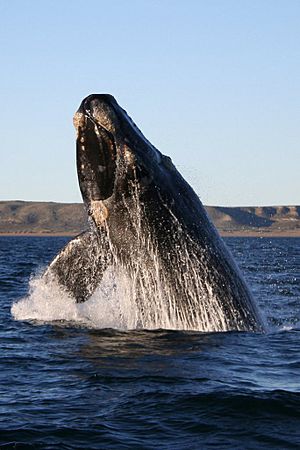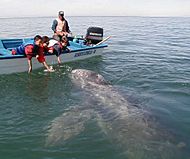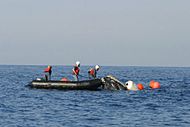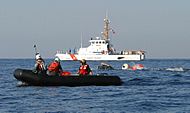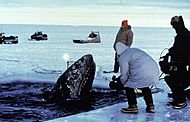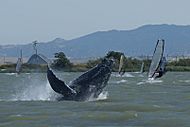Cetacean surfacing behaviour facts for kids
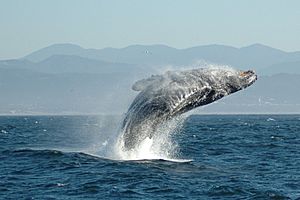
Cetacean surfacing behaviour describes the cool moves that cetaceans make at the water's surface. These amazing animals include whales, dolphins, and porpoises. They don't just come up to breathe! They use these special surface actions for many reasons. These include showing off, finding food, and talking to each other. All types of cetaceans, big and small, perform these behaviours.
Cetaceans are usually divided into two main groups. One group, called Odontoceti, has teeth. This group includes dolphins and porpoises. The other group, Mysticeti, has baleen plates instead of teeth. Baleen is like a giant filter. When we talk about behaviour, it's often easier to think of them in two ways. There are the really big ones, like most whales, which are over 10 meters long. Then there are the smaller ones, like dolphins and porpoises, which are less than 10 meters long. Even orcas, which are big, are in the smaller, toothed group.
Some behaviours are done by both big and small cetaceans. These include spyhopping, where they lift their head out of the water. Logging is when they float still like a log. Lobtailing is when they slap their tail on the surface. But some actions are only done by one group. For example, bow riding (swimming in front of a boat) is mostly for dolphins. Peduncle throws (a powerful tail move) are more common in large whales. People often see these exciting behaviours. This has led to lots of scientific studies. It has also created a popular whale watching industry.
How Long Do Whales Dive?
The time whales spend underwater can change a lot. It depends on the type of whale and what they are doing. Some whales can dive for a very long time. For example, some species can stay underwater for up to 85 minutes when they are hunting. There are even records of Cuvier's beaked whales diving for over three hours! This usually happens in very unusual situations.
Whales and People
-
A Humpback whale and kayakers near Avila Beach, California
-
Rescuing a North Atlantic right whale from fishing gear
-
"Dawn" the whale in the Sacramento River
-
A Bottlenose dolphin and a paddler near Dalkey Island
Whale watching is a popular activity all over the world. In 2008, about 13 million people went whale watching. This, along with more boats on the water, might affect how cetaceans behave. When boats come close, most cetaceans either try to avoid them or sometimes seek them out. They usually don't change their behaviour if they are just traveling or eating. But they do change if they are doing other surface activities.
If whales want to avoid boats, they might dive deeper. They might also swim away from the boats. For example, sperm whales dive less often when boats are near. They also take shorter breaths. They might not show their tail fluke as often before a deep dive. Humpback whales without calves also do fewer acrobatic moves when boats are within 300 meters.
Avoiding boats is common for large whales. But interactions are more common for whale groups with babies. They are also more common for smaller cetaceans like dolphins. Studies on killer whales in North America show this. They slapped their tails more when boats were within 100 meters. About 70% of their surface activities happened when a boat was within 225 meters. Similarly, dusky dolphins jump more and swim in tighter groups when boats are around. This is especially true if boats don't follow safe distance rules.
Whale watching tours want people to see exciting behaviours. So, they might get too close to the animals. We don't fully understand the long-term effects of whale watching. But it's possible that whales might avoid popular areas. It could also mean they use up more energy trying to avoid boats.
See also
- Beached whale
- Tail-walking


